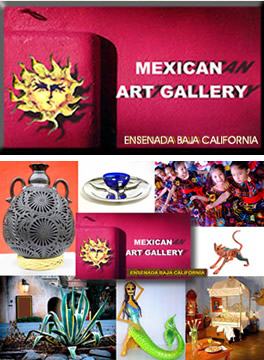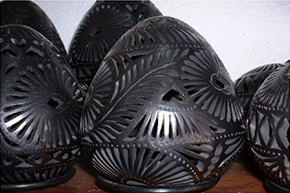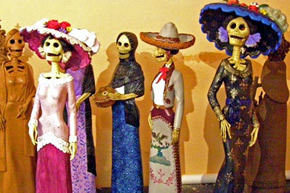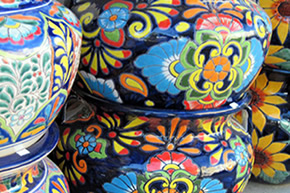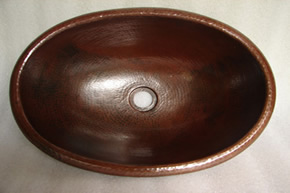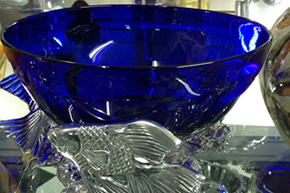It is wonderful for home accenting. Pewter crafts make great gifts. Better yet, you can enjoy the exquisite beauty and craftsmanship yourself. Mexican pewter is a non-toxic alloy of aluminum and the tableware pieces can be used for preparation and serving. Each piece is sand-casted by hand and polished by skilled metal craft artisans.
Pewter is a wonderful metal with a long history. The origin of the word Pewter is not fully known, but it is probably an English modification of the word spelter. It was adopted with only slight variation by most of the continental European nations.
At an early period Europeans became very fond of pewter wares. The word pewter became peauter in Dutch, peutre, peautre or piautre in French,
peltro in Italian and peltre in Spanish. Roman pewter, the oldest known, which has been uncovered at various sites in England and elsewhere, was composed of tin and lead alone. Occasional traces of iron are believed to be accidental.
Some people think of Pewter as a cheap substitute for Sterling silver but this it is not. Pewter is a splendid metal with its own merits and qualities that make it a fine precious metal for both decorative and practical applications. Pewter historically was an alloy of *tin and lead (up to 50% Pb). It became popular in kitchen ware such as plates, mugs, and utensils. By the mid-1700s the health hazards and tarnishing drawbacks of leaded pewter helped popularize Britannia metal a non-leaded form of pewter. Britannia metal
consists of tin, antimony, and copper. Pewter is a general name used to denote a number of alloys of various metals in diverse proportions, the sole common feature of which lies in the fact that tin is always the chief constituent. Tin (Sn) is a relatively soft and ductile metal with a silvery white color. It has a density of 7.29 grams per cubic centimeter, a low melting point of 231.88° C (449.38° F), and a high boiling point of 2,625° C (4,757° F). Most people think of tin cans when they hear the word tin and that makes them think "Cheap". Tin cans were in fact made from iron that was dipped in tin to prevent rusting. Today's "Tin foil" is actually made of aluminum!

Oaxacan black clay or black pottery is a traditional, pre-Columbian art form of Oaxaca, Mexico. Until the 1950s, local artisans originally used the unique local clay to create ceramic containers for the use of transporting mescal from hillside farms to sell in the local communities. Created by well-known and respected artisans in Oaxaca, Mexico...
Read More
Noble, stately and proud, La Calavera Catrina – or the "Skeleton of the Female Dandy" - has been an icon of Mexican Pop Art since the days before the Mexican Revolution. Often associated with the Mexican holiday, Día de los Muertos (Day of the Dead, November 2nd), the true history of La Catrina is one of politics and revolution...
Read More
Alebrijes are carved wooden figures created by Oaxacan artisans. They have become so popular that even the world’s most respected Spanish language authority, the La Real Academia de la Lengua Española, Spanish Royal Academy, has included the term “Alebrijes” in its official Spanish language dictionary. The term “Alebrijes” originated from...
Read More
The Talavera pottery has its roots in the Arab-Andalusia culture in Spain. About 8 centuries ago Arab potters settled in a location now days known as Talavera de la Reina and established and developed the techniques and procedures to create the earthenware known as Majolica. The word Majolica originated in Italy and it refers to a process that the Italians used...
Read More
In pre-colonial times, local Indians mined for copper in various regions of Mexico including the state of Michoacan in Central Mexico and used it to manufacture all kinds of wares and artwork. In 1538, the Spanish missionary, Vasco de Quiroga, established various schools, hospitals and libraries to educate and care for the local Indians of Central Mexico. In Michoacan...
Read More
The history of Mata Ortiz, both the village and the pottery, can be traced through the archeological remains of nearby Paquimé, a pre-Columbian city state. From its modest beginnings around 700ADE, Paquimé grew into the center of political and commercial life of the Rio Grande River Valley. By its peak in the 14th century, Paquimé boasted....
Read More
Pewter is a wonderful metal with a long history. The origin of the word Pewter is not fully known, but it is probably an English modification of the word spelter. It was adopted with only slight variation by most of the continental European nations. Some people think of Pewter as a cheap substitute for Sterling silver but this it is not. Pewter is a splendid metal...
Read More
In each country or culture where kites have been used, the people there developed special names for them. These names reflected the ideas that people had about their kites, the way they looked, or the reasons they flew them. In English, the word "kite" is also the name of a graceful bird. In Mexico, the word for kite is "papalote". That's also the Mexican...
Coming Soon

